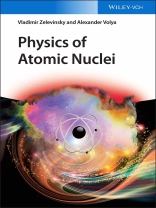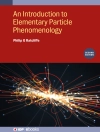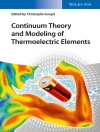This advanced textbook presents an extensive and diverse study of low-energy nuclear physics considering the nucleus as a quantum system of strongly interacting constituents.
The contents guide students from the basic facts and ideas to more modern topics including important developments over the last 20 years, resulting in a comprehensive collection of major modern-day nuclear models otherwise unavailable in the current literature. The book emphasizes the common features of the nucleus and other many-body mesoscopic systems currently in the center of interest in physics. The authors have also included full problem sets that can be selected by lecturers and adjusted to specific interests for more advanced students, with many chapters containing links to freely available computer code. As a result, readers are equipped for scientific work in mesoscopic physics.
Cuprins
Dedication xiii
Preface xv
1 Building Blocks and Interactions 1
1.1 What Are the Nuclei Made Of? 1
1.2 Proton and Neutron 3
1.3 Strong Interactions 4
1.4 Electromagnetic Interactions and Charge Distribution 5
1.5 Magnetic Properties 10
1.6 Weak Interactions 11
1.7 Neutron Decay 13
1.8 Nuclear World 15
References 19
2 Isospin 21
2.1 Quantum Numbers in the Two-Body Problem 21
2.2 Introducing Isospin 23
2.3 Isospin Invariance 25
2.4 Space–Spin Symmetry and Isospin Invariance 26
2.5 Glimpse of a More General Picture 30
2.6 Relations between Cross Sections 31
2.7 Selection Rules 35
2.8 Isobaric Mass Formulae 38
References 41
3 Two-Body Dynamics and the Deuteron 43
3.1 Low-Energy Nuclear Forces 43
3.2 Example: Argonne Potential 45
3.3 Meson Exchange 48
3.4 Deuteron: Central Forces and s-Wave 51
3.5 Tensor Forces and d-Wave 55
3.6 Magnetic Dipole Moment 58
3.7 Electric Quadrupole Moment 59
References 65
4 Two-Body Scattering 67
4.1 Scattering Problem 67
4.2 Phase Shifts 69
4.3 Scattering Length 71
4.4 Sign of the Scattering Length 78
4.5 Resonance Scattering at Low Energies 80
4.6 Effective Radius 82
4.7 Scattering of Identical Particles 83
4.8 Coulomb Scattering 86
4.9 Coulomb-Nuclear Interference 87
References 89
5 Liquid Drop Model 91
5.1 Binding Energies 91
5.2 Shape Variables 95
5.3 Microscopic Variables 97
5.4 Multipole Moments 98
5.5 Kinetic Energy and Inertial Parameters 100
5.6 Shape Vibrations 102
5.7 Stability of the Charged Spherical Liquid Drop 104
References 111
6 Vibrations of a Spherical Nucleus 113
6.1 Sound Waves 113
6.2 Isovector Modes 117
6.3 Giant Resonance and Linear Response 119
6.4 Classification of Normal Modes 121
6.5 Quantization of Nuclear Vibrational Modes 125
6.6 Multiphonon Excitations 128
6.7 Angular Momentum Classification 132
References 134
7 Fermi Gas Model 135
7.1 Mean Field and Quasiparticles 135
7.2 Perfect Fermi Gas 137
7.3 Ground State 138
7.4 Correlation Between Particles 142
7.5 Asymmetric Systems and Chemical Equilibrium 143
7.6 Pressure and Speed of Sound 146
7.7 Gravitational Equilibrium 148
7.8 Nuclear Matter Equation of State 150
References 151
8 Spherical Mean Field 153
8.1 Introduction 153
8.2 Magic Numbers 153
8.3 Separation Energy 155
8.4 Periodicity of Nuclear Spectra 156
8.5 Harmonic Oscillator Potential 157
8.6 Orbital Momentum Representation 160
8.7 Square Well Potential 162
8.8 Spin–Orbit Coupling 163
8.9 Realistic Level Scheme 165
8.10 Semiclassical Origins of Shell Structure 166
References 168
9 Independent Particle Shell Model 169
9.1 Shell Model Configurations 169
9.2 Particle–Hole Symmetry 171
9.3 Magnetic Moment 172
9.4 Quadrupole Moment 174
9.5 Recoil Corrections 177
9.6 Introduction to Group Theory of Multiparticle Configurations 178
References 183
10 Light Nuclei 185
10.1 A Short Walk along the Beginning of the Nuclear Chart 185
10.2 Halo in Quantum Systems 190
10.3 Nuclear Halos 192
10.4 One-Body Halo 193
10.5 Two-Body Halos 195
10.6 Efimov States 199
References 202
11 Many-Body Operator Formalism 203
11.1 Secondary Quantization 203
11.2 Physical Observables: One-Body Operators 208
11.3 Two-Body Operators 209
11.4 Interparticle Interaction 210
11.5 Interaction in a Spherical Basis 213
11.6 Recoupling of Angular Momentum 215
References 222
12 Nuclear Deformation 223
12.1 Idea of Nuclear Deformation 223
12.2 Collective Model 224
12.3 Adiabatic Approximation 226
12.4 Onset of Deformation 228
12.5 Quadrupole Deformation in the Body-Fixed Frame 230
12.6 Quadrupole Shape Variables 232
12.7 Variety of Quadrupole Shapes 233
12.8 Empirical Deformation 235
12.9 Single-Particle Quantum Numbers 239
12.10 Anisotropic Harmonic Oscillator 240
12.11 Asymptotic Quantum Numbers 245
12.12 Nilsson Potential 246
12.13 More Examples 247
References 250
13 Pairing Correlations 251
13.1 Physical Evidence 251
13.2 Seniority Scheme 256
13.3 Multipole Moments in the Seniority Scheme 260
13.4 Degenerate Model 261
13.5 Canonical Transformation 265
13.6 BCS Theory: Trial Wave Function 269
13.7 Energy Minimization 271
13.8 Solution for the Energy Gap 273
13.9 Excitation Spectrum 276
13.10 Condensation Energy 278
13.11 Transition Amplitudes 279
References 281
14 Gamma-Radiation 283
14.1 Introduction 283
14.2 Electromagnetic Field and Gauge Invariance 283
14.3 Photons 285
14.4 Interaction of Radiation with Matter 288
14.5 Radiation Probability 291
14.6 Electric Dipole Radiation 292
14.7 Electric Quadrupole Radiation 295
14.8 Magnetic Dipole Radiation 296
14.9 Photoabsorption 298
14.10 Multipole Expansion 299
References 303
15 Nuclear Gamma-Transitions and Related Electromagnetic Processes 305
15.1 Single-Particle Transitions 305
15.2 Collective Transitions 308
15.3 Nuclear Isomerism 310
15.4 Isospin 312
15.5 Structural Selection Rules 315
15.6 Monopole Transitions 318
15.7 Internal Electron Conversion 320
15.8 Coulomb Excitation 322
15.9 Nuclear Photoeffect 326
15.10 Electron Scattering 330
References 335
16 Nuclear Rotation 337
16.1 Introduction: Rotational Bands 337
16.2 Finite Rotations 345
16.3 Rotation Matrices as Functions on the Group 346
16.4 Euler Angles 347
16.5 Angular Momentum in Euler Angles 351
16.6 Eigenfunctions of Angular Momentum 354
16.7 Rigid Rotor 355
16.8 Symmetry Properties 357
16.9 Simplest Solutions 358
16.10 Ground-State Band 359
16.11 Intensity Rules 360
16.12 Electric Quadrupole Moment 363
16.13 Magnetic Moment 366
16.14 Symmetry Properties Revisited 367
16.15 Coriolis Mixing and Decoupling Parameter 368
16.16 Classical Rotation and Routhian 370
16.17 Cranked Rotation 372
16.18 Moment of Inertia 375
16.19 Adiabatic Expansion 377
16.20 Rotation of a Perfect Fermi Gas 379
16.21 Perfect Bose Gas and Ideal Liquid 381
16.22 Pairing Effects 384
16.23 Band Crossing 385
References 388
17 Self-Consistent Field 391
17.1 Exchange Interaction 391
17.2 Hartree–Fock Equations 395
17.3 Operator Formulation 397
17.4 Single-Particle Density Matrix 398
17.5 Hartree–Fock–Bogoliubov Approximation 400
17.6 General Canonical Transformation 402
17.7 Solutions 404
17.8 Generalized Density Matrix 407
17.9 Pairing and Particle Number Conservation 409
17.10 Effective Interaction 411
17.11 Skyrme Functionals 413
17.12 Generalization to Nonzero Temperature 418
References 419
18 Collective Modes 421
18.1 Schematic Model 421
18.2 Random Phase Approximation 426
18.3 Canonical Form of the RPA 427
18.4 Model with Factorized Forces 430
18.5 Collective Modes as Bosons 432
18.6 Mapping of Dynamics 433
18.7 Normalization and the Mass Parameter 435
18.8 Symmetry Breaking 438
18.9 Generator Coordinate Method 444
References 446
19 Bosons, Symmetries and Group Models 447
19.1 Introduction 447
19.2 Low-Lying Quadrupole Excitations as Interacting Bosons 448
19.3 Algebra of Boson Operators 450
19.4 Subgroups and Casimir Operators 452
19.5 s–d Model 455
19.6 Irreducible Representations and Quantum Numbers 458
19.7 Vibrational Limit 461
19.8 o G(6) Limit 466
19.9 o Ko M(3) Limit 468
19.10 Shapes and Phase Transitions in the IBM 470
References 473
20 Statistical Properties 475
20.1 Introduction 475
20.2 Level Density: General Properties 478
20.3 Darwin–Fowler Method 480
20.4 Relation to Statistical Thermodynamics 482
20.5 Thermodynamics of a Nuclear Fermi Gas 483
20.6 Statistics of Angular Momentum 486
20.7 Shell Model Monte Carlo Approach 488
20.8 Thermodynamics of Compound Reactions 490
20.9 Statistical Description of Resonances 492
References 497
21 Nuclear Fission 499
21.1 Introduction 499
21.2 Alpha-Decay 502
21.3 Neutron Fission 505
21.4 Photofission 509
21.5 Fission as a Large-Amplitude Collective Motion 510
21.6 Nonadiabatic Effects and Dissipation 512
21.7 Fission Isomers 514
21.8 Parity Violation in Fission 518
References 522
22 Heavy-ion Reactions: Selected Topics 525
22.1 Introduction 525
22.2 Experimental Indications 526
22.3 Macroscopic Description 530
22.4 Equilibration as a Diffusion Process 534
22.5 Toward a Microscopic Description 540
22.6 Sketch of a More General Approach 541
22.7 A Simple Model 545
22.8 Nuclear Multifragmentation 547
22.9 More about Fusion Reactions 550
References 553
23 Configuration Interaction Approach 555
23.1 Center-of-Mass Problem 555
23.2 Matrix Elements of Two-Body Interactions 558
23.3 Ab initio Approach 559
23.4 Three-Body Forces 564
23.5 Semiempirical Effective Interactions 565
23.6 Shell-Model Hamiltonian, Properties and Solutions 570
23.7 Effective Non-Hermitian Hamiltonian 571
23.8 From Isolated to Overlapping Resonances 576
23.9 Realistic Nuclear Calculations 581
References 583
24 Weak Interactions 585
24.1 Introduction 585
24.2 Beta-Spectrum in the Simplest Case 587
24.3 Nuclear Transitions 590
24.4 Dirac Formalism 595
24.5 Four-Fermion Theory 599
24.6 Nuclear Structure Effects 601
24.7 Parity Violation 604
24.8 Electric Dipole Moment 607
24.9 Nuclear Enhancement 609
24.10 On the Way to Electroweak Theory 612
24.11 Higgs Mechanism 616
24.12 Neutrino: Oscillations 618
24.13 Neutrino:Majorana or Dirac? 620
References 623
25 Nucleus as a Chaotic System 627
25.1 Introduction 627
25.2 Strength Function 628
25.3 Level Density Revisited 633
25.4 Complexity of Wave Functions 636
25.5 Correlations between Classes of States 639
25.6 Invariant Entropy 643
25.7 Random Matrix Ensembles 646
25.8 Thermalization 650
References 652
General Nuclear Data Resources 655
Index 657
Despre autor
Vladimir Zelevinsky is professor at the Department of Physics and Astronomy and at the National Superconducting Cyclotron Laboratory at Michigan State University, USA. In the 1980s he was Head of the Theory Division at the Budker Institute and Head of Theoretical Physics at Novosibirsk University, Russia. He spent three years as visiting professor at the Niels Bohr Institute in Copenhagen, Denmark. He is the author of over 250 scientific publications, deputy editor of the EPL journal and associate editor of the journal Nuclear Physics. He is also the author of Quantum Physics, 2 Volume Set, published with Wiley VCH in 2010.
Alexander Volya is professor of Physics at the Florida State University, USA. His education includes diploma from Tallinn Tynismae Science School, Estonia; bachelor’s degree from St. Petersburg State University, Russia; doctoral degree in theoretical nuclear physics from Michigan State University; and postgraduate research work at the Argonne National Laboratory. In the fall of 2003, he joined the faculty at Florida State University where he currently leads a research program in theoretical nuclear physics and mesoscopic physics. He has published over 100 publications and has been regularly teaching nuclear physics courses at Florida State University.












